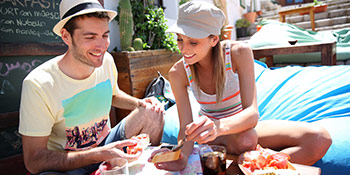Phone: + 39 0541 798670 E-mail: office@bistravel.it
Sardinia, Italy
Sardinia, ITALIAN REGIONS-
 View Largebtravel_sardinia_1
View Largebtravel_sardinia_1 -
 View Largebtravel_sardinia_2
View Largebtravel_sardinia_2 -
 View Largebtravel_sardinia_3
View Largebtravel_sardinia_3 -
 View Largebtravel_sardinia_4
View Largebtravel_sardinia_4 -
 View Largebtravel_sardinia_5
View Largebtravel_sardinia_5 -
 View Largebtravel_sardinia_6
View Largebtravel_sardinia_6 -
 View Largebtravel_sardinia_7
View Largebtravel_sardinia_7 -
 View Largebtravel_sardinia_8
View Largebtravel_sardinia_8
A voyage over an emerald sea, past characteristic coves and beaches of snowwhite sand … this is Sardinia, an island that strikes its visitors with natural contrasts, the lights and colors of a region that boasts old traditions and a wild and pure nature.
Situated in the middle of the Mediterranean Sea, Sardinia is a mainly mountainous region, without high peaks, with a vast and charming, yet bittersweet, natural environment. In fact, the presence of man does not seem to affect this territory; great surfaces still preserve their natural composition, luxuriant woods with even millenary trees, small desert areas and marshes inhabited by deer, wild horses and rapacious birds.
The sea reigns over this region with its colors that migrate into the coves, along the coasts, towards the beaches and the most popular resorts. An example is the Costa Smeralda (Emerald Coast) with Porto Cervo set as its gemstone and uniting the history and culture of ancient traditions with a joyful and colourful nightlife. Porto Cervo was named after its enchanting cove that resembles the antlers of a deer; the Old Port is considered the best-equipped touristic port in the Mediterranean Sea. Porto Rotondo is also a famous location; it overlooks the wide Gulf of Cugnana and is full of villas and piazzas swathed by such a splendid natural environment as this.
Those who prefer the mountains can explore the area of Gennargentu, the vastest mountain range in Sardinia; with its peculiar landscape, it proves that the loveliest painter of them all is Mother Nature herself. This region is rich in flora and fauna, with its mouflons, golden eagles, Sardinian deer and several other species now threatened with extinction.
Among its wonders, Sardinia offers the visitor the Nuragic complexes scattered all over the territory. These monuments are unique to the world, testifying to an ancient culture that – though it endured from the 16th to 15th Centuries B.C. still rains rather mysterious. The Nuragic constructions were built using great blocks of stone and developed around a central cone-shaped tower that communicates strength and power. These are archaeological sites where it is possible to grasp the archaic charm of ancient rituals and domestic life. Of these many constructions, the Barumini complex, in the Province of Cagliari, is among the sites in the UNESCO World Heritage List.
The provinces of the region are: Cagliari (regional capital), Carbonia-Iglesias, Nuoro, Olbia-Tempio, Oristano, Medio Campidano, Sassari and Ogliastra.

It is not easy to make a list of all the amazing beauties of Sardinia. Places like San Teodoro, Santa Teresa di Gallura, Poltu Quatu, and Baia Sardinia are only some of the charming locations that deserve a visit.
Visiting the Maddalena Archipelago and its “seven sisters,” the main islands of the archipelago, and sailing along the coast of the Maddalena National Park with its lively seabeds, perfect for scuba-diving lovers, is an incredible experience.
Caprera, the second biggest Island after Maddalena, is full of pastures and pinewoods, and shows its visitors the places where Garibaldi lived, with a house museum in the typical Mediterranean vegetation, which guards the memorabilia of the “hero of two worlds,” as well as his and his family’s grave.
Sailing from Caprera to the Bocche di Bonifacio, you will be struck by the beauty of Budelli Island, wild and uninhabited, with its enchanting Rosa beach, a natural masterpiece named for the pink hues of its special corals and shells.
Again on Sardinia’s northwest coast, in front of the Natural Park of Asinara Island, we can find one of the most famous tourist resorts, Stintino, which combines the charm of a lively fishing village with high-quality accommodation facilities. This small seaside town, appearing as a painting with its white houses and the contrast between the crystal-clear sea and light blue sky, offers endless leisure possibilities, from golf to excursions and scuba diving, from cycling to horseback riding.
In front of the well-known La Pelosa Beach is the homonymous Tower, a 16th-Century Aragonese structure, one of the oldest sighting towers in Sardinia. On the central-east coast of the island, in the Gulf of Orosei, are extraordinary white-sand beaches, and a wild and savage nature. Many caves and coves are the destination of tourists who want to discover unparalleled views and sensations; Cala Biriola, Grotta Bue Marino, Cala Liberotto, Cala Goloritzè are some of those natural sceneries where time seems to stand still.
Sardinia combines sea and nature with folk traditions, mysticism and curiosities, like the mysterious giant’s tombs, ancient caves dug out of the ground and scattered around the region, just like the Nuragic constructions; and Domus de Janas (or the “House of Witches”) in Sulcis Iglesiente. These stone towers are the biggest and best-preserved megalithic monuments in Europe; the most important town with Nuragic traces is Su Nuraxi di Barumini near Cagliari, inscribed on the UNESCO World Heritage List.
In Cagliari, besides admiring the several colonies of flamingos of the lagoon, be sure to witness a few of the traditional festivals and fairs that take place all year-round, like the beautiful Festival of Sant’Efisio, one of the most important religious and folklore events in Sardinia.
Heading back to Oristano, top off your itinerary with a stop at the Roman archaeological site, Tharros, and enjoy its breathtaking view of the sea.

Stintino offers endless possibilities for a leisurely vacation: golfing, boat excursions and scuba diving, relaxing strolls, cycling and horseback riding, as well as exploring the hinterland to admire the typical Mediterranean vegetation or ancient archaeological finds, such as the Nuragic constructions near Porto Torres.
Staying in this area is even more interesting if you watch or take part in the “Regata della Vela Latina” (the Latin Sailboat Regatta), an important international event dedicated to the ancient sport of sailing. Hundreds of traditional sailing boats arrive from all over Italy to race in the crystal-clear sea near Stintino every August. The Vela Latina was the typical Mediterranean sail since the period of the Maritime Republics.
The Maddalena Archipelago, with its windy islands full of natural inlets and picturesque landfalls, is the ideal destination for sailing, but also for horseback riding and mountain biking – they are alternative ways to enjoy sunset on the beach, as well as natural sceneries amidst thriving cistus and gorse bushes.
It is worth taking a trip to the National Park of Asinara on the homonymous Island, considered to be one of the most charming in the Mediterranean Sea, full of colonies of white donkeys that still live in the wild. There is a wide range of activities to choose from and practice, of course all with respect for Park Norms: from trekking along thematic routes, to cycling, riding horses born and bred on the Island, sailing, guided scuba diving and even partaking in a rubber-tire train tour to admire the most evocative landscapes in the area.
In Gennargentu, an enormous and particularly beautiful mountain range, it is possible to undertake a number of activities, including trekking and excursions to archaeological sites, as well as skiing on the slopes of Bruncu Spina, one of the highest peaks at 1, 829 meters (6, 000 feet), and Mount Spada, with its skiing facilities and restaurant.

Sardinian food satisfies the most demanding palates with its simple and natural ingredients, and with its delicious recipes made with the delicate and strong local products. The main ingredient is wheat, used to make the famous pane carasau, but also the well-known malloreddus, culurgiones and fregola.
You cannot leave the island without tasting the savory porceddu, a grilled suckling pig which is served on cork trays and covered in myrtle branches. As for fish, the lobster of Alghero, the bottarga of Cabras and Carloforte tuna fish are excellent. Other exclusive fish dishes are clam soup and spaghetti with sea urchins.
Sausages and cheeses are some of the tastiest local products, and Sardinian pecorino is certainly the most renowned.
And to drink? Accompany your meals with excellent wines, such as Vermentino di Gallura or Cannonau. Myrtle liqueur (Mirto) is delicious as well.

NEWSLETTER